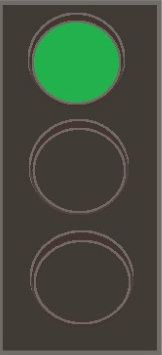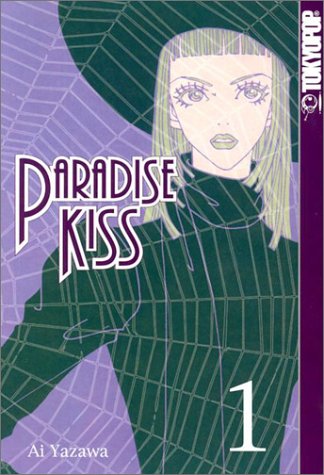PARADISE KISS (Paradaisu Kisu), by Ai Yazawa. First published in 1999, and first published in North America in 2002.
PLOT: Yukari is a hard-working high-school student who admittedly is working more towards pleasing her demanding mother than to satisfy her own needs. One day on the way to cram school, she is cornered by a punk (safety pin facial piercings and all ) and a transvestite. The next thing she knows, she is whisked off to The Studio, the basement studio where Arashi (the punk) and Isabella (the transvestite) work along with tiny, adorable Miwako and the handsome, alluring George on a dress for their art school's annual show, and they want Yukari to be their model. Yukari firmly refuses, but a lost student ID allows George to lure her back and urge her to agree. Soon enough, her own focus begins to shift away from endless tests and her crush on classmate Hiro and towards her new friends and a burgeoning relationship with George.
STORY: I think what makes Paradise Kiss so great is partially due to how character driven it is, and partially because of how well those characters are written in the first place.
Yazawa is a great writer, and in particular she is great at writing female leads. Yukari is amusing in how high-strung and repressed she is, but we also get hints of something sadder and even a little desperate within her. You can understand why she fights tooth and nail against getting sucked into this new world, struggling to return to her comfort zone even if that comfort zone frankly makes her miserable. It's also interesting to watch her struggle with her growing attraction to George. Hiro may be very much the kind of boy you take home to mother, but George is good looking, very charming, and already is giving off mixed signals, which only serves to drive Yukari closer even when he frustrates her. It also serves to keep George from being too perfect, lest he come off as some sort of inhuman ideal. The rest of cast is equally appealing, from brash, angry Arashi, sweet, childlike Miwako, and motherly Isabella. All of them are interesting characters in their own right, and it's easy to be just as invested in them as it is in Yukari and George.
Admittedly, there's not a lot of plot yet beyond what I have described - most of this volume is spent setting up the plot and cast and Yukari's conflict between school and the Studio. Thankfully, with a cast like this, it's more than enough to satisfy the reader.
ART: Yazawa's character designs strike a nice balance between their realistic faces and their long, lanky stylized bodies, garbed in wonderfully well-drawn clothes. It's not hard to guess that Yazawa's background was in art, particularly in fashion design. She's one of the few mangaka in my experience who can draw truly handsome men - not the anime-styled bishonen you tend to see in shoujo, but genuinely, realstically handsome men, and I can't deny that I enjoyed the eye candy.
The panels are packed together tightly, and also notably outlined in unusually thick, dark lines. Between that and how much everybody in this manga talks, it can make the pages a bit busy and sometimes a little hard to follow, although this is less of a concern in the omnibuses than in the single volumes. Backgrounds tend to shift between nicely hand-drawn rooms and more impressionistic city scapes, which tend to appear during Yukari's more introspective moments. While Yazawa does tend to break out the screentones and effects from time to time, she tends to layer two or three of them together. This not only creates a result which is more visually appealing than its components, but also resembles the pattern on a cloth, a subtle and story-appropriate touch.
Yazawa's overall art style strikes a nice balance between realistic detail and fashion-influence stylization, and the result is a feast for the eyes. This is the work of a confident, experience mangaka who is clearly in her zone.
PRESENTATION: In the single volume release, there's an omake where the cast hunt down the author and are generally very meta, as well as a 2-page biographical essage on Yazawa. Sadly, these were not carried over into the omnibus rerelease, where the only extra is a single color page. The omnibus is printed in a much larger size than the single volumes, allowing the artwork some room to breathe.
I also do have to note the difference in translation between the two. As typical for a Tokyopop release, the single volume's translation is looser and more conversational, whereas the Vertical omnibus release has a more straightforward translation, which does lose something of a personality. Which is better? Honestly, that will depend on your own tastes and standards. Neither diminish the story, but both bring their own take on it.
RATING:
 Good josei may be hard to find, but thank goodness that no longer holds true for my favorite manga from that genre. It's as handsome as it is well-written, and I cannot recommend it hard enough.
Good josei may be hard to find, but thank goodness that no longer holds true for my favorite manga from that genre. It's as handsome as it is well-written, and I cannot recommend it hard enough.This was first published in the USA by Tokyopop, and was licence rescued by Vertical. All 5 single volumes were released by Tokyopop and are now out of print. The first of three omnibuses is currently in print from Vertical, with the second coming in December 2012.
You can purchase this volume and many more like it through RightStuf.com!


No comments:
Post a Comment